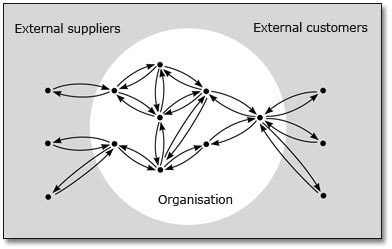4: Customers
Another way of thinking about your audience is as customers and suppliers (see Figure 2). You may think that a word like ‘customer’ simply means someone who goes into a shop to buy something and that this is not a term that is relevant to fundraisers in non-profit organisations unless they are running charity shops or other trading activities. However, we want to use the term in its wider marketing sense as representing those who are involved in an exchange relationship with you. You offer them something they need, and they reciprocate with something of value to you – be it funding, time, attention, approval or opportunities. Their involvement in reciprocal exchanges with you usually makes them both customers and suppliers at the same time.
Unlike stakeholders, ‘customers’ carries a strong implication that you are there to serve them and, equally, that those who are your suppliers also have a duty to provide you with good service. These customers may be internal (such as the workers whose projects are funded by your fundraising activities) or external (such as donors or funders – whether individuals, corporate or institutional).
What other customers and suppliers can you identify? (If you find the term customer really difficult then you might consider going back to the term audience for your activities).
Perhaps you thought of your service users, or the volunteers who work in your organisation. You may have found it quite difficult to identify your customers and particularly to start thinking about other employees in other parts of the organisation in this way. Moreover, it may not always appear that your colleagues see you as a customer, for example when you ask the finance section again for a breakdown of the payments and receipts for the last fundraising campaign. This illustrates that besides customers you also have suppliers. Again there will be both internal and external suppliers whose relationships with you may be quite complex and sometimes seem to work against one another. Often marketing textbooks depict these relationships as a supply chain but it may be more helpful in the context in which you are working to think of these relationships as a supply network.
Activity 2
You should allow 0 hour(s), 10 minute(s).
- List your main internal and external customers and suppliers.
- Draw the supply network showing how it relates to your role.
Thinking about your work relationships in this way helps you to understand how your work and skills contribute to the work of the organisation as a whole and its delivery to its customers.
That makes it all sound so simple doesn’t it? But assessing and addressing the differing expectations of your various customers and suppliers can feel like a balancing act. In thinking about customers, it can be helpful to try to put yourself in their shoes. What does your job and your organisation look like to the external world? And how do your colleagues, your internal customers and suppliers, see your role and the organisation? Whether we call them audiences, stakeholders or customers, understanding, responding to, and managing their perceptions is a significant challenge in winning resources and support.

